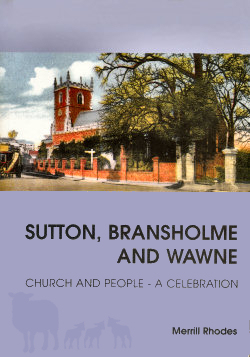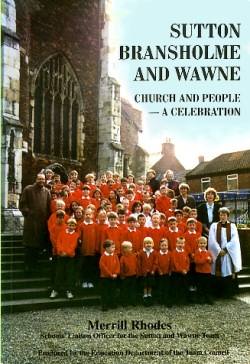
 SUTTON
SUTTONBRANSHOLME & WAWNE Church & People - a celebration by Merrill Rhodes |
|
Home Page Wawne Common Farm
and the Swifts Gibraltar and Ings
Farms Kenneth Beaulah and
Meaux
As we have seen, Robert Swift held on to
Wawne Common Farm after 1911; it then occupied about 131 acres of arable and
pasture, and the good-sized farmhouse boasted six bedrooms. Robert had been the
tenant since 1895. The farm lies off the beaten track, on Benningholme Lane,
just across the Holderness Drain - colloquially known as 'Auld Sal'. Robert
married Kate Calvert, of Smithy Farm, Fairholme Lane, in St Peter's church in
1901.
Smithy Farm on left, blacksmith's & joiner's shops, former school
The couple had three sons, Robert,
born 1902, Harry in 1904, and Arthur in 1905, who all later bought the farm;
also a daughter Kathleen, born 1908. Arthur kept a diary for many years, from
the age of 16, presenting a picture of life on the farm in the 1920s, when
everything had to be done by hand.1
Wawne Common c1922: Bill Hodgson, Arthur, Harry and Robert Swift
The diaries tell of the 16 evacuees who came to Meaux from Hull in 1939. It was compulsory to accommodate the children,
and the Swifts gladly took in two boys aged 6 and 7 years. Don Farnill
stayed until he was 13, and loved the family and farm, still keeping in touch
with Bob's son, John. The latter tells of an incident fairly recently when
the other evacuee, Dennis Pearson, arrived unexpectedly to show his son
"where I was during the War." He, too, still writes.
A young waggoner at Wawne Common in
1913, Walter Warman, was killed near Ypres in the First War.2 His initials can
still be seen in brickwork at the farm.
Arthur's diaries describe the work
of the farm through the Second War, the 35 degrees of frost in the hard January
of 1940 being just one more difficulty. 19 March 1941:
"Last night was the roughest night of the war. Thousands of incendiaries
and many high explosives. A land mine dropped near our 16-acre pond. It blew out all
our windows and tiles off every building, all of Cowhouse. Some incendiaries
fell at Gibsons, some in Backyard. Beacon crew3 came in and we
did not go to Bed at all.'
The three brothers then owned Wawne
Common and also bought Bridge Farm. Bob's wife Tet, raised funds for a carpet
for St Peter's, and after she died in 1978 her husband Bob, completed the
project. Their son John, took on the farm, living at Bridge Farm, and his son
continues the family tradition - at present at Givendale. Kath Swift lived on
at Wawne Common until about 1994. When this much-loved lady died, the farmhouse
which the family had occupied for a century, had to be sold.
Kath Swift feeding an orphan lamb
Kate Calvert's mother had been a
Hudson before marriage, and the family lived at Gibraltar Farm.
George Hudson's 21st Birthday Party, 17 May 1894
Gibraltar and Ings Farms lay at the
south-western corner of Wawne township, close to the River Hull. A drainage map
of 1848 shows no fewer than 15 'shuttle' services across the river, including
Hudson's Shuttle from Gibraltar, and Ramsey's Shuttle from Ings. The monks of
Meaux had their fishhouse, with ponds and mills, at the south-west of Gibraltar,
and had a vaccary or pasture for cattle on the land, and later, sheepcots. When
excavations were under way for the new Kingswood Bridge, fragments of pottery
were found, suggesting a Romano-British settlement near to Gibraltar.
Map of 1868 showing the Wawne farms
Even in our turbulent lives today,
it is possible to stand near that water-drenched ground by the Kingswood Bridge
and imagine the monks working their mills in that far-off time.
A certain little boy was fired with
enthusiasm for the history of his area around 1915. His name was Kenneth
Beaulah, born 1910. His family had been in Wawne since 1870, settling at
Bamforth Farm in Ferry Lane. When he was 2, Kenneth's father George,
became tenant of Meaux Abbey Farm after the sale of the Windham Estate.
It was built in 1801; wall anchors bear the date and initials R.W., presumably
Robert Wise, who held the farm then. The brick farmhouse stands in the grounds
of the former abbey, on the site of a former house. George Beaulah recalled the
remaining abbey archway and stones, still standing until c1900.4
Remains of Meaux Abbey 1898
The young Kenneth recalled the farm
workers often coming in with tiles from the stackyard - "Abbey
bricks," they called them. Tiling from the abbey decorated the back room
of one of the farmworker's cottages. Kenneth began to make a small museum
in his bedroom. He went away to school, but left at 16. Tom Sheppard, who
had seen some of Kenneth's heraldic designs, offered him work at Hull Museum in
Albion Street. Weekends at home were often spent chasing around on a motor-bike
searching for tiles.
"At Whalley,"
5 recalled Kenneth,
"a gardener looking after the site had found tiles and stacked them in a
shed. I spent two hours with a bucket of water cleaning those tiles, but he let
me take some samples. I found out later that they were valuable examples of
ornamental design." Mr Beaulah's passion for antiquary and tile collection
were to last all his life. "I met Fred Foot Walker at the East Riding
Antiquarian Society. He would cycle to Meaux from Hull nearly every weekend for
seven years - with his spade over his shoulder - and together we searched out
and pieced together many tiles, building up the museum at the top of the
house." 6
In 1924, following up a local
tradition that there were a well and underground passage at Meaux, the teenager
discovered a tunnel, and in 1928 when this was excavated, it was found to be 54
feet in length, and eight feet in height, with regular openings to the land
surface.7
Kenneth Beaulah at 17,
After graduating in 1933, Kenneth
Beaulah made Heraldry his profession, and his work on Meaux was virtually 'on
hold' for some years, though he continued building up his collections of tiles
and also fine art paintings, books, coins and medals.8 When he retired, Mr Beaulah
constructed a plan of Meaux Abbey which he and Mr Foot Walker had 'stepped out'
many years before, from studies of other Cistercian abbeys and by following the
lines of the old walls. The plan below, and key, may help further study.9
Kenneth Beaulah died in 1995, and a chalice and patten were presented to St Peter's church to commemorate him.
His brother Fred, died in 1993, and service books are dedicated in his memory.
Their brother John Beaulah, lives on in Wawne, also a great benefactor and supporter of the church where the monks
of Meaux said their divine services all those years ago.
GKB: Meaux Abbey as it appeared in 1500
1 Thanks to Miss Kath Swift and nephew John for loaning the diaries
2 Research by John Swift
3 This crew lived in a caravan in the field, and kept a beacon alight to deflect enemy aircraft from Hull
4 Information from son, John Beaulah, brother of Kenneth
5 Site of ruined abbey, near Clitheroe
6 GK Beaulah's paper to the ERAS on the Paving Tiles from Meaux describes the tiles and their manufacture in detail
7 An account of this appears in an article of the ERAS by Tom Sheppard
8 I had the privilege of seeing his museum at Hessle
9 Previously unpublished material, by kind permission of Mrs Beaulah
|











